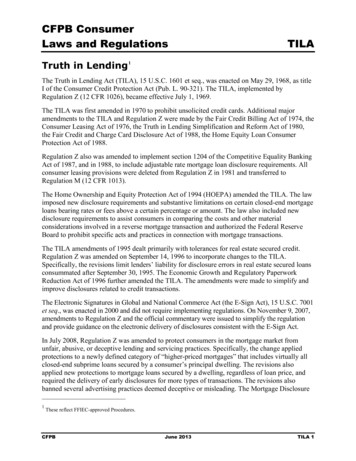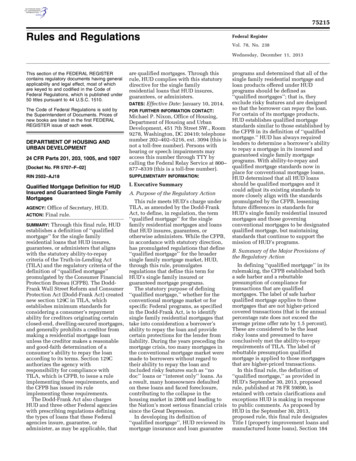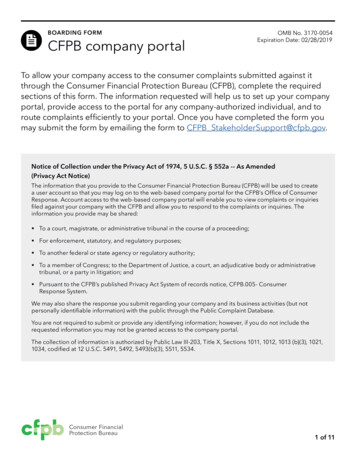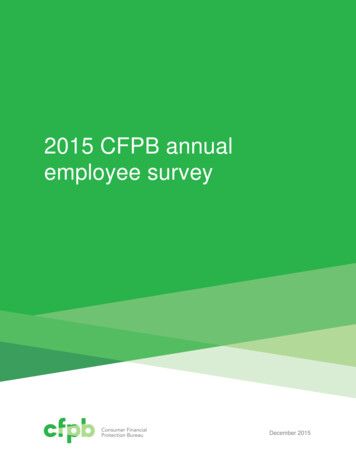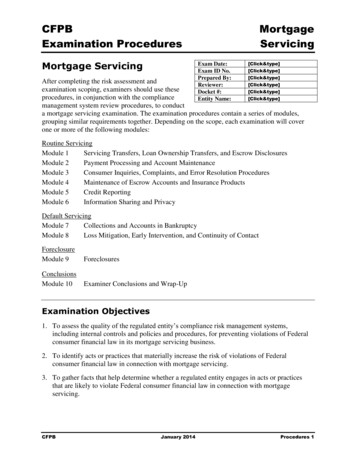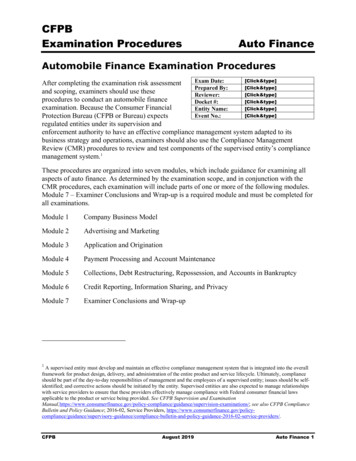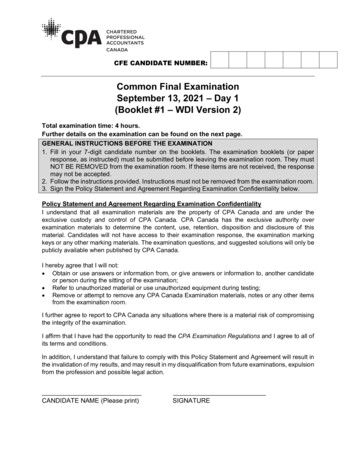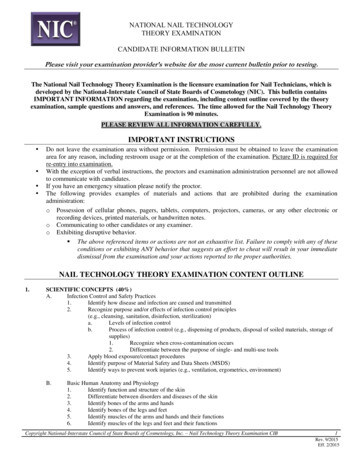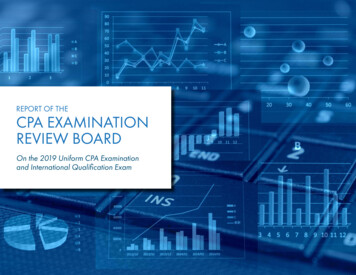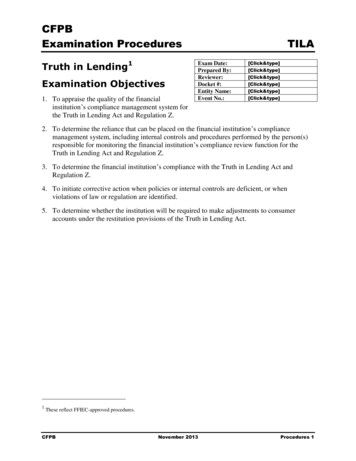
Transcription
CFPBExamination ProceduresTruth in Lending1Examination Objectives1. To appraise the quality of the financialinstitution’s compliance management system forthe Truth in Lending Act and Regulation Z.TILAExam Date:Prepared By:Reviewer:Docket #:Entity Name:Event e][Click&type][Click&type]2. To determine the reliance that can be placed on the financial institution’s compliancemanagement system, including internal controls and procedures performed by the person(s)responsible for monitoring the financial institution’s compliance review function for theTruth in Lending Act and Regulation Z.3. To determine the financial institution’s compliance with the Truth in Lending Act andRegulation Z.4. To initiate corrective action when policies or internal controls are deficient, or whenviolations of law or regulation are identified.5. To determine whether the institution will be required to make adjustments to consumeraccounts under the restitution provisions of the Truth in Lending Act.1These reflect FFIEC-approved procedures.CFPBNovember 2013Procedures 1
CFPBExamination ProceduresTILAGeneral Procedures1. Obtain information pertinent to the area of examination from the financial institution‘scompliance management system program (historical examination findings, complaintinformation, and significant findings from compliance review and audit).2. Through discussions with management and review of the following documents, determinewhether the financial institution‘s internal controls are adequate to ensure compliance in thearea under review. Identify procedures used daily to detect errors/violations promptly. Also,review the procedures used to ensure compliance when changes occur (e.g., changes ininterest rates, service charges, computation methods, and software programs). Organizational charts. Process flowcharts. Policies and procedures. Loan documentation and disclosures. Checklists/worksheets and review documents. Computer programs.3. Review compliance review and audit workpapers and determine whether:a. The procedures used address all regulatory provisions (see Transactional Testingsection).b. Steps are taken to follow up on previously identified deficiencies.c. The procedures used include samples that cover all product types and decision centers.d. The work performed is accurate (through a review of some transactions).e. Significant deficiencies, and the root cause of the deficiencies, are included in reports tomanagement/board.f. Corrective actions are timely and appropriate.g. The area is reviewed at an appropriate interval.4. Review the financial institution‘s record retention practices to determine whether evidence ofcompliance is retained for at least:a. Two years after the disclosures were required to be made or other action was required tobe taken, other than for the advertising requirements and certain requirements formortgages described below. (§1026.25(a))CFPBNovember 2013Procedures 2
CFPBExamination ProceduresTILAb. Three years after the date of receipt of payment to show compliance with loan originatorcompensation requirements. (§1026.25(c)(2))c. Three years after consummation to show compliance with ability-to-repay minimumstandards (§1026.43(c)-(f)) and prepayment penalty restrictions (§1026.43(g)) for loanssecured by a dwelling. (§1026.25(c)(3))Disclosure Forms5. Determine if the financial institution has changed any TILA disclosure forms or if there areforms that have not been previously reviewed for accuracy. If so:Verify the accuracy of each disclosure by reviewing the following: Credit card application/solicitation disclosures (§1026.60(b)-(e)). HELOC disclosures (§1026.40(d) and (e)). Initial disclosures (§1026.6) and, if applicable, additional HELOC disclosures(§1026.40). Periodic statement disclosures (§1026.7) Statement of billing rights and change in terms notice (§1026.9(a),(b),(c) or (g)). Note and/or contract forms (including those furnished to dealers). Notice of Right to Rescind/Cancel (§§1026.15(b), 1026.23(b)(1)) and 1026.47(c)(4). Standard closed-end credit disclosures (§§1026.17(a) and 1026.18). ARM disclosures (§1026.19(b)). High-cost mortgage disclosures (§1026.32(c)). Reverse mortgage disclosures (§1026.33(b)). Private education loan disclosures (§1026.47).CFPBNovember 2013Procedures 3
CFPBExamination ProceduresTILAClosed-End Credit Disclosure Forms Review Proceduresa. Determine that the disclosures are clear, conspicuous, and grouped together or segregatedas required, in a form the consumer may keep. The terms “Finance Charge” and “AnnualPercentage Rate” and corresponding rates or amounts should be more conspicuous thanother terms, except for the creditor’s identity. For private student loans the term “AnnualPercentage Rate” and corresponding rate must be less conspicuous than the term “financecharge” and the corresponding amount, as well as less conspicuous than the interest rate,the notice of the right to cancel and creditor’s identity. (§§1026.17(a), 1026.47(b), and (c))b. Determine the disclosures include the following as applicable. (§1026.18)1. Identity of the creditor2. Brief description of the finance charge3. Brief description of the APR4. Variable rate information (§1026.18(f)(1) or (2))5. Payment schedule6. Brief description of the total of payments7. Demand feature8. Description of total sales price in a credit sale9. Prepayment penalties or rebates10. Late payment amount or percentage11. Description for security interest12. Insurance conditions for finance charge exclusions (§1026.4(d))13. Statement referring to the contract14. Statement regarding assumption of the note15. Statement regarding required deposits.c. Determine that the creditor discloses the number, amounts, and timing of paymentsscheduled to repay the obligation (other than for a transaction that is subject to section1026.18(s)2. (§1026.18(g))2For example, home construction loans that are secured by real property or a dwelling are subject to §1026.18(s) and not§1026.18 (g). See comment App. D-6 of Regulation Z.CFPBNovember 2013Procedures 4
CFPBExamination ProceduresTILAd. For a closed-end transaction secured by real property or a dwelling (other than atransaction secured by a consumer’s interest in a timeshare plan described in 11 U.S.C.101(53D)), determine that the creditor discloses the following information about theinterest rate and payments, as applicable (§1026.18(s)):Interest Rates1. For a fixed-rate mortgage, the interest rate at consummation. (§1026.18(s)(2)(i)(A))2. For an adjustable-rate or step-rate mortgage (§1026.18(s)(2)(i)(B)):i. The interest rate at consummation and the period of time until the first interestrate adjustment may occur, labeled as the “introductory rate and monthlypayment;”NOTE: As set forth in comment 18(s)-1, if periodic payments are not due monthly,the creditor should use the appropriate term, such as “quarterly” or “annually.”ii. The maximum interest rate that may apply during the first five years after the dateon which the first regular periodic payment will be due and the earliest date onwhich that rate may apply, labeled as “maximum during first five years;” andiii. The maximum interest rate that may apply during the life of the loan and theearliest date on which that rate may apply, labeled as “maximum ever.”3. For a loan that provides for payment increases occurring without regard to aninterest rate adjustment 3 (as described in section 1026.18(s)(3)(i)(B)), the interestrate in effect at the time the first such payment increase is scheduled to occur and thedate on which the increase will occur, labeled as “first adjustment” if the loan is anadjustable-rate mortgage or, otherwise, labeled as “first increase.”4(§1026.18(s)(2)(i)(C))4. For a negative amortization loan5 (§1026.18(s)(2)(ii)):i. The interest rate at consummation and, if it will adjust after consummation, thelength of time until it will adjust, and the label “introductory” or “intro”;ii. The maximum interest rate that could apply when the consumer must beginmaking fully amortizing payments under the terms of the legal obligation;3Note: this category includes interest-only loans, as set forth in comment §1026.18(s)(2)(i)(C)-1.4Because model forms and clauses published by the CFPB are safe harbors, this rate may also be labeled “Maximum Ever,”pursuant to §1026.18(s)(2)(i)((B)(3).5The term “negative amortization loan” means a loan, other than a reverse mortgage subject to section 1026.33 that provides fora minimum periodic payment that covers only a portion of the accrued interest, resulting in negative amortization.(§1026.18(s)(7)(v))CFPBNovember 2013Procedures 5
CFPBExamination ProceduresTILAiii. If the minimum required payment will increase before the consumer must beginmaking fully amortizing payments, the maximum interest rate that could apply atthe time of the first payment increase and the date the increase is scheduled tooccur; andiv. If a second increase in the minimum required payment may occur before theconsumer must begin making fully amortizing payments, the maximum interestrate that could apply at the time of the second payment increase and the date theincrease is scheduled to occur.5. For an amortizing adjustable-rate mortgage, if the interest rate at consummation isless than the fully indexed rate, the following (placed in a box directly beneath thetable required by paragraph 18 (s)(1) of the regulation, in a format substantiallysimilar to Model Clause H–4(I) in the regulation’s appendix H):i. The interest rate that applies at consummation and the period of time for which itapplies;ii. A statement that, even if market rates do not change, the interest rate will increaseat the first adjustment and a designation of the place in sequence of the month oryear, as applicable, of such rate adjustment (e.g., “in the third year”); andiii. The fully-indexed rate.Payments for Amortizing Loans1. Principal and interest payments. If all periodic payments will be applied to accruedinterest and principal, for each interest rate disclosed under section 1026.18(s)(2)(i)(§1026.18(s)(3)(i)):i. The corresponding periodic principal and interest payment, labeled as “principaland interest;”ii. If the periodic payment may increase without regard to an interest rateadjustment, the payment that corresponds to the first such increase and the earliestdate on which the increase could occur;iii. If an escrow account is established, an estimate of the amount of taxes andinsurance, including any mortgage insurance payable with each periodic payment;andiv. The sum of the amounts disclosed under sections 1026.18(s)(3)(i)(A) and (C) or(s)(3)(i)(B) and (C), as applicable, labeled as “total estimated monthly payment.”2. Interest-only payments. If the loan is an interest-only loan, for each interest ratedisclosed under section 1026.18(s)(2)(i), the corresponding periodic payment and(§1026.18(s)(3)(ii)):CFPBNovember 2013Procedures 6
CFPBExamination ProceduresTILAi. If the payment will be applied to only accrued interest, the amount applied tointerest, labeled as “interest payment,” and a statement that none of the paymentis being applied to principal;ii. If the payment will be applied to accrued interest and principal, an itemization ofthe amount of the first such payment applied to accrued interest and to principal,labeled as “interest payment” and “principal payment,” respectively;iii. The escrow information described in section 1026.18(s)(3)(i)(C); andiv. The sum of all amounts required to be disclosed under sections1026.18(s)(3)(ii)(A) and (C) or (s)(3)(ii)(B) and (C), as applicable, labeled as“total estimated monthly payment.”3. Payments for negative amortization loans. If the loan is a negative amortization loan(§1026.18(s)(4)):i. The minimum periodic payment required until the first payment increase orinterest rate increase, corresponding to the interest rate disclosed under section1026.18(s)(2)(ii)(A);ii. The minimum periodic payment that would be due at the first payment increaseand the second, if any, corresponding to the interest rates described in section1026.18(s)(2)(ii)(C) and (D);iii. A statement that the minimum payment pays only some interest, does not repayany principal, and will cause the loan amount to increase;iv. The fully amortizing periodic payment amount at the earliest time when such apayment must be made, corresponding to the interest rate disclosed under section1026.18 (s)(2)(ii)(B); andv. If applicable, in addition to the payments in sections 1026.18(s)(4)(i) and (ii), foreach interest rate disclosed under section 1026.18(s)(2)(ii), the amount of the fullyamortizing periodic payment, labeled as the “full payment option,” and astatement that these payments pay all principal and all accrued interest.NOTE: The information in sections 1026.18(s)(2)–(4) must be disclosed in theform of a table with no more than five columns, and with headings and formatsubstantially similar to Model Clause H–4(E), H–4(F), H–4(G), or H–4(H) inappendix H of the regulation. The table should contain only the informationrequired in sections 1026.18 (s)(2)–(4), be placed in a prominent location, and bein a minimum 10-point font. (§1026.18(s)(1))4. Balloon payments. For loans with balloon payments (defined as a payment that ismore than two times a regular periodic payment) (§1026.18(s)(5)):CFPBNovember 2013Procedures 7
CFPBExamination ProceduresTILAi. Except as provided below, the balloon payment is disclosed separately from otherperiodic payments disclosed in the table (i.e., is outside the table and in a mannersubstantially similar to Model Clause H–4(J) in appendix H to the regulation);ii. If the balloon payment is scheduled to occur at the same time as another paymentrequired to be disclosed in the table, the balloon payment must be disclosed in thetable.e. For a closed-end transaction secured by real property or a dwelling (other than atransaction secured by a consumer’s interest in a timeshare plan described in 11 U.S.C.101(53D)), that is a negative amortization loan, determine that the following informationis disclosed (in close proximity to the table required in section 1026.18(s)(1), withheadings, content, and format substantially similar to Model Clause H–4(G) in appendixH to this part) (§1026.18(s)(6)):i. The maximum interest rate, the shortest period of time in which such interest ratecould be reached, the amount of estimated taxes and insurance included in eachpayment disclosed, and a statement that the loan offers payment options, two ofwhich are shown; andii. The dollar amount of the increase in the loan’s principal balance if the consumermakes only the minimum required payments for the maximum possible time and theearliest date on which the consumer must begin making fully amortizing payments,assuming that the maximum interest rate is reached at the earliest possible time.f. For a closed-end transaction secured by real property or a dwelling, (other than atransaction secured by a consumer’s interest in a timeshare plan described in 11 U.S.C.101(53D)), determine that the creditor disclosed a statement that there is no guarantee theconsumer can refinance the transaction to lower the interest rate or periodic payments.(§1026.18(t)(1))NOTE: The statement required by section 1026.18(t)(1) should be in a form substantiallysimilar to Model Clause H–4(K) in appendix H to the regulation. (§1026.18(t)(2))g. Determine all variable rate loans with a maturity greater than one year secured by aprincipal dwelling are given the following disclosures at the time of application.(§1026.19)1. Consumer Handbook on Adjustable Rate Mortgages or substitute2. Statement that interest rate payments and or terms can change3. The index/formula and a source of information4. Explanation of the interest rate/payment determination and margin5. Statement that the consumer should ask for the current interest rate and marginCFPBNovember 2013Procedures 8
CFPBExamination ProceduresTILA6. Statement that the interest rate is discounted, if applicable7. Frequency of interest rate and payment changes8. Rules relating to all changes9. Either a historical example based on 15 years, or the initial rate and payment with astatement that the periodic payment may substantially increase or decrease togetherwith a maximum interest rate and payment10. Explanation of how to compute the loan payment, giving an example11. Demand feature, if applicable12. Statement of content and timing of adjustment notices13. Statement that other variable rate loan program disclosures are available, if applicableh. Determine that for any closed-end adjustable-rate mortgage with a maturity date greaterthan one year, secured by a principal dwelling, the creditor, assignee, or servicer providesthe following initial rate adjustment disclosures (for disclosure timing requirements, seeTiming Requirements below): (§1026.20(d)(2))1. The date of the disclosure;2. An explanation that under the terms of the consumer’s adjustable rate mortgage, thetime frame that the current rate has been in effect, when the current rate is scheduledto expire, the effective date of the new rate, when additional future interest rateadjustments are scheduled to occur and any other changes to loan terms, features, andoptions taking effect on the same date, and how the rate change may affect thepayment and other loan terms;3. A table explaining the current interest rate and payment, the new interest rate andpayment, and the date the first new payment is due;NOTE: For interest-only and negative amortization adjustable-rate mortgages, thetable must include how the current and new rates and payment will be allocated tointerest, principal, and escrow (if applicable). See section 1026.20(d)(2)(iii)(C) formore on payment allocation disclosure requirements.4. An explanation of how the interest rate is determined, including the specific index orformula used and a source of information about that index or formula, and the typeand amount of any adjustment, including a margin and an explanation that a margin isthe addition of a certain number of percentage points to the index;5. Any limits on the interest rate or payment increases at each interest rate adjustmentand over the life of the loan (as applicable), including the extent to which such limitsresult in the creditor, assignee, or servicer foregoing any increase in the interest rateCFPBNovember 2013Procedures 9
CFPBExamination ProceduresTILAand the earliest date that such foregone interest rate increases may apply to futureinterest rate adjustments, subject to those limits;6. An explanation of how the new payment was determined, including the index orformula used to determine the new interest rate;7. Any adjustments to the index or formula used to determine the new payment, such asthe addition of a margin;8. The expected loan balance on the date of the interest rate adjustment;9. The remaining loan term expected on the date of the interest rate adjustment and anychanges to the term that may have occurred due to the interest rate change;10. If an estimated rate payment is provided, a statement that another disclosure with theactual interest rate will be provided to the consumer between two and four monthsprior to the first payment at the adjusted level is due, and that the creditor is using anestimated rate;11. If applicable, a statement that the new payment will not be allocated to pay loanprincipal and will not reduce the loan balance. If the new payment will result innegative amortization, a statement that the new payment will not be allocated to payloan principal and that only part of the interest will be paid, which will add to theloan balance. If the new payment will result in negative amortization as a result ofthe interest rate adjustment, the statement must set forth the payment required tofully amortize the remaining balance at the new interest rate over the remainder ofthe loan term;12. A statement indicating the circumstances under which any prepayment penalty maybe imposed, the time period during which it may be imposed, and a statement that theconsumer may contact the servicer for additional information, including themaximum amount of the penalty that may be charged to the consumer;13. A telephone number of the creditor, assignee, or servicer to call if the consumeranticipates not being able to make the new payment;14. A statement listing alternatives that consumers may pursue if they anticipate notbeing able to make the new payment;15. A web address to access either the CFPB or the Department of Housing and UrbanDevelopment’s (HUD) approved list of homeownership counselors and counselingorganizations, the HUD toll-free number to access the HUD list of homeownershipcounselors and counseling organizations, and the Bureau website to access statehousing finance authorities’ contact information.i. Determine that for any closed-end adjustable-rate mortgage with a maturity date greaterthan one year, secured by a principal dwelling, the creditor, assignee, or servicer providesCFPBNovember 2013Procedures 10
CFPBExamination ProceduresTILAthe following rate adjustment disclosures for rate adjustments with a correspondingpayment change (for disclosure timing requirements see Timing Requirements below):(§1026.20(c))NOTE: A creditor, assignee or servicer subject to the Fair Debt Collection Practices Act(FDCPA) that has received the consumer’s notification to cease communication pursuantto FDCPA section 805(c) is exempt from this requirement.1. An explanation that under the terms of the consumer’s adjustable rate mortgage, thetime frame that the current rate has been in effect is ending and the interest rate andpayment will change, the effective date of the new rate, when additional future interestrate adjustments are scheduled to occur and any other changes to loan terms, features,and options taking effect on the same date, such as the expiration of interest-only orpayment-option features; a table explaining the current interest rate and payment, thenew interest rate and payment, and the date the first new payment is due;NOTE: For interest-only and negatively amortizing payments, the table must includehow the current and new rates and payment will be allocated to interest, principal, andescrow (if applicable). See section 1026.20(d)(2)(iii)(C) for more on paymentallocation disclosure requirements.2. An explanation of how the interest rate is determined, including the specific index orformula used and a source of information about that index or formula, and the typeand amount of any adjustment, including a margin and an explanation that a margin isthe addition of a certain number of percentage points to the index, and any applicationof previously foregone interest rate increases from past rate adjustments;3. Any limits on the interest rate or payment increases at each interest rate adjustmentand over the life of the loan (as applicable), including the extent to which such limitsresult in the creditor, assignee, or servicer foregoing any increase in the interest rateand the earliest date that such foregone interest rate increases may apply to futureinterest rate adjustments, subject to those limits;4. An explanation of how the new payment is determined, including the index orformula used to determine the new interest rate;5. Any adjustments to the index or formula used to determine the new payment, such asthe addition of a margin or the application of any previously foregone interest rateincreases from past interest rate adjustments;6. The expected loan balance on the date of the interest rate adjustment;7. The remaining loan term expected on the date of the interest rate adjustment and anychanges to the term that may have occurred due to the interest rate change;8. If applicable, a statement that the new payment will not be allocated to pay loanprincipal and will not reduce the loan balance. If the new payment will result inCFPBNovember 2013Procedures 11
CFPBExamination ProceduresTILAnegative amortization, a statement that the new payment will not be allocated to payloan principal and that only part of the interest will be paid, which will add to theloan balance. If the new payment will result in negative amortization as a result ofthe interest rate adjustment, the statement must set forth the payment required tofully amortize the remaining balance at the new interest rate over the remainder ofthe loan term;9. A statement indicating the circumstances under which any prepayment penalty maybe imposed, the time period during which it may be imposed, and a statement that theconsumer may contact the servicer for additional information, including themaximum amount of the penalty that may be charged to the consumer;NOTE: Model and sample disclosures H-4(D)(1) through (4) containing all necessaryinformation can be found in appendix H. The disclosures required under section1026.20(c) and (d) generally should be in the form of a table and in the same order as,and with headings and format substantially similar to, the model disclosures(§§1026.20(c)(3) and (d)(3)).NOTE: When examining a creditor, an assignee, or a servicer that continues to ownthe loan, if the entity states that another entity has the obligation to provide thedisclosures, examiners should determine whether the entity takes steps to ensure thatthe other party (the creditor, assignee, or servicer, as applicable) is complying withthe obligation to provide the disclosures.j. Determine that the disclosures required for high-cost mortgage transactions (§1026.32)clearly and conspicuously include the items below. (§1026.32(c), see Form H-16 inappendix H)1. The required statement “you are not required to complete this agreement merelybecause you have received these disclosures or have signed a loan application. If youobtain this loan, the lender will have a mortgage on your home. You could lose yourhome, and any money you have put into it, if you do not meet your obligations underthe loan.”2. The APR.3. Amount of the regular monthly (or other periodic) payment and the amount of anyballoon payment. The regular payment should include amounts for voluntary items,such as credit life insurance or debt-cancellation coverage, only if the consumer haspreviously agreed to the amount (See the commentary to section 1026.32(c)(3)).4. Statement that the interest rate may increase and monthly payment may increase, andthe amount of the single maximum monthly payment, based on the maximum interestrate allowed under the contract, if applicable.5. The amount borrowed. For a closed-end mortgage, the amount borrowed is the totalamount borrowed, as reflected by the face amount of the note; and where the amountCFPBNovember 2013Procedures 12
CFPBExamination ProceduresTILAborrowed includes premiums or other charges for optional credit insurance or debtcancellation coverage (grouped together with the amount borrowed), that fact shall bestated. For an open-end credit plan, the amount borrowed is the credit limit for theplan when the account is opened.k. For any closed-end mortgage loan (credit transaction that is secured by the principaldwelling of a consumer) that was sold, assigned, or otherwise transferred to the coveredperson, determine that the covered person notifies the borrower clearly and conspicuouslyin writing, in a form that the consumer may keep of such transfer, including (§1026.39):1. An identification of the loan that was sold, assigned, or otherwise transferred;2. The name, address, and telephone number of the covered person who owns themortgage loan;3. The date of transfer (either the date of acquisition recognized in the books and recordsof the covered person or that of the transferring party) identified by the coveredperson;4. The name, address, and telephone number of an agent or party having authority, onbehalf of the covered person, to receive notice of the right to rescind and resolveissues concerning the consumer’s payments on the mortgage loan;5. Where transfer of ownership of the debt to the covered person is or may be recordedin public records or, alternatively, that the transfer of ownership has not beenrecorded in public records at the time the disclosure is provided; and,6. At the option of the covered person, any other relevant information regarding thetransaction.7. If there are multiple covered persons, contact information for each of them, unlessone of them has been authorized to receive the consumer’s notice of the right torescind and resolve issues concerning the consumer’s payments on the loan.NOTE: This notice of sale or transfer must be provided for any consumer credittransaction that is secured by the principal dwelling of a consumer. This notificationis required of the covered person even if the loan servicer remains the same. Inaddition, if more than one consumer is liable on the obligation, the covered personmay mail or deliver the disclosure notice to any consumer who is primarily liable.And, if an acquisition involves multiple covered persons who each acquire a partialinterest in the loan pursuant to separate and unrelated agreements, each coveredperson has a duty to ensure that disclosures related to its acquisition are accurate andprovided in a timely manner unless an exception in section 1026.39(c) applies. Theparties may, but are not required to, provide a single notice that satisfies the timingand content requirements applicable to each covered person. (Commentary1026.39(b)(5)–2)CFPBNovember 2013Procedures 13
CFPBExamination ProceduresTILAl. For private education loans subject to Subpart F, ensure that the required disclosures areaccurate (§1026.47) and contain the following information:1. Application or solicitation disclosures disclose the following:a. Interest rate, including:i. Rate or range, and if the rate depends in part on a determination of theborrower’s creditworthiness or other factors, a statemen
Truth in Lending Act and Regulation Z. 3. To determine the financial institution’s compliance with the Truth in Lending Act and Regulation Z. 4. To initiate corrective action when policies or internal controls are deficient, o
